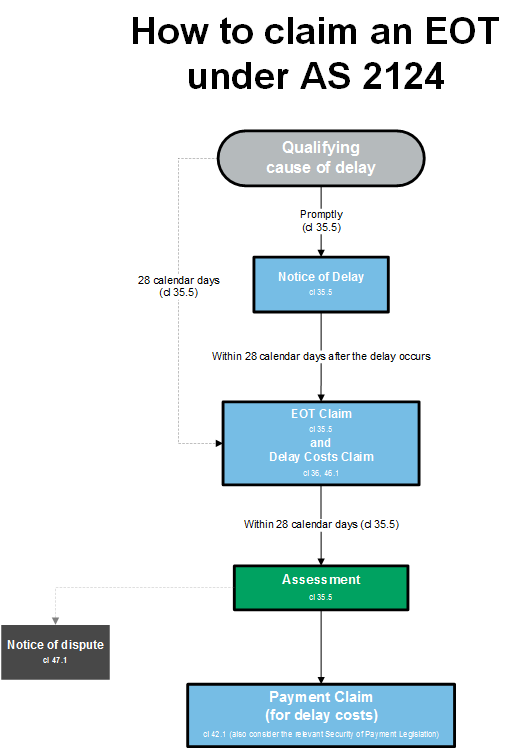This article explains how to claim an extension of time (EOT) under AS 2124. It includes a flowchart to explain the process.

Under AS 2124, you can only claim an extension of time if you are delayed by a cause identified in clause 35.5. Relevantly, you can claim for:
(a) any event that occurs on or before the date for practical completion that is beyond the reasonable control of the contractor (including, but not limited to, industrial conditions and inclement weather);
(b) any of the following events which occurs before, on or after the date for practical completion:
(i) delays caused by the principal, superintendent, or the principal’s employees, consultants, other contractors or agents;
(ii) quantities of work being greater than the quantities in the bill of quantities or as stated in the annexure (other than a variation);
(iii) latent conditions;
(iv) variations directed under clause 40;
(v) repudiation or abandonment by a nominated subcontractor;
(vi) changes in the law;
(vii) directions by municipal, public or statutory authorities but not where the direction arose from a failure of the contractor to comply with the requirements of Commonwealth or State or Territory legislation, regulations, ordinances, orders, or directions by statutory authorities (see clause 14.1);
(viii) delays by municipal, public or statutory authorities not caused by the contractor;
(ix) claims in respect of the right of the principal to construct the work under the contract on the site (see clause 17.1(v));
(x) any breach of contract by the principal; and
(xi) any other cause which is expressly stated in the contract to be a cause for extension of time for practical completion.
These are discussed in more detail here.
2. Translate the delay into ‘days’
When you identify a period of ‘days’ in a contractual notice, be clear about which type of ‘day’ you are referring to. Your options are:
- calendar days;
- business days; or
- working days (for example, where your program is based on a 6 or 7 day working week).
There is no harm in including more than one type of day (e.g. working days and calendar days) in your notices. The key is to ensure that you are consistent, and to demonstrate how you have arrived at the claimed number of days.
Working days are often used as the starting point, because a calculation in working days can then be used to determine a specific date to which the date for practical completion should be extended. Working days can often be readily extracted from the contractor’s program, and thinking in terms of working days can sometimes make concurrent delays easier to explain and quantify.
Some superintendents and principals prefer to think in calendar days (or business days), because their main concern is the date on which the principal will be given possession of the works.
These different perspectives on ‘days’ are why notices expressing a delay in different types of ‘day’ can be useful.
3. Be mindful of concurrent delays
It is important to note that one distinguishing feature of the AS 2124 is the way it deals with concurrent delays.
If a delay is caused by multiple causes of delay and any of the causes would not entitle the contractor to claim an EOT, the contractor will not be entitled to an EOT in respect of the delay.
4. Submit a notice of delay
If you become aware of anything that may delay the work under the contract, clause 35.5 requires the contractor to ‘promptly’ submit a written notice of the delay to the superintendent. The notice required under clause 35.5 is a simple one. It must identify:
- the cause of the delay; and
- details of the possible delay, including an estimate of the delay.
If there is insufficient information to be confident about the likely duration of the delay, as a matter of prudence you should say so (and explain why) in your notice. If you are unable to provide a precise estimate, a range of estimates should be acceptable (e.g. ‘between 4 and 5 weeks’).
If your project is divided into separable portions, your notices should identify which portions are (or may be) affected by a delay.
Clause 7 of AS 2124 requires a notice to be sent to the address of the other party as stated in the contract, or last communicated in writing. You can read about serving notices by email here.
5. Submit a claim for an EOT and delay costs (if applicable)
An EOT claim is dealt with in the third paragraph of clause 35.5 of AS 2124. It requires a written claim for an EOT to be submitted within 28 calendar days after the delay occurs.
It is important to appreciate that a notice of delay under the first paragraph of clause 35.5 and a claim for an EOT under the third paragraph of clause 35.5 are two different things.
The purpose of a notice of delay is to bring a probable delay to the superintendent’s attention. The purpose of an EOT claim is to formally claim an extension of time if the delay eventuates (and assuming it involves a valid cause of delay).
An EOT claim under clause 35.5 must identify:
- the facts on which the claim is based; and
- the number of days extension claimed.
Typically, the best way to demonstrate the impact of a delay is by including an impacted program that shows how the critical path is affected by the event which has caused the delay.
When assessing your EOT claim, the superintendent is required to take into account whether you have “taken all reasonable steps to preclude the occurrence of the cause and minimise the consequences of the delay”. Because of this, you can sometimes explain in your EOT claim what steps you have taken to prevent and/or mitigate the delay.
6. Delay or disruption costs
Clause 36 entitles the contractor to claim any extra costs necessarily incurred by reason of a delay that is the subject of an EOT, where the delay has been caused by:
- the Principal, the Superintendent, the Principal’s employees, consultants, other contractors or agents; or
- any other event identified in the Annexure Part A, or another part of the contract, as a cause of delay for which delay and disruption costs are payable. Examples of causes falling within this description are clauses 8.1 and 12.3. You can read more about clause 36 here.
Although clause 36 does not set out any requirements for what a delay cost claim must include, clause 46.1 requires the contractor to:
- identify the cause of the delay;
- explain why you are entitled to claim delay costs (including the provision of the contract which is the basis for the claim); and
- identify the quantum of the claim and include relevant supporting documentation.
Keep in mind that you will only be entitled to claim any extra costs necessarily incurred. Losses, damages or other liabilities falling outside that description cannot be included.
Contractors will often include their claim for delay costs in their claim for an EOT. There is no harm in taking this approach.
7. Assessment
The superintendent is required to give a written direction with its assessment of the EOT within 28 calendar days of receiving your claim. If you disagree with the superintendent’s assessment, you can issue a notice of dispute under clause 47.1.
8. Resources
Download a print-friendly PDF copy of our flowchart here.






